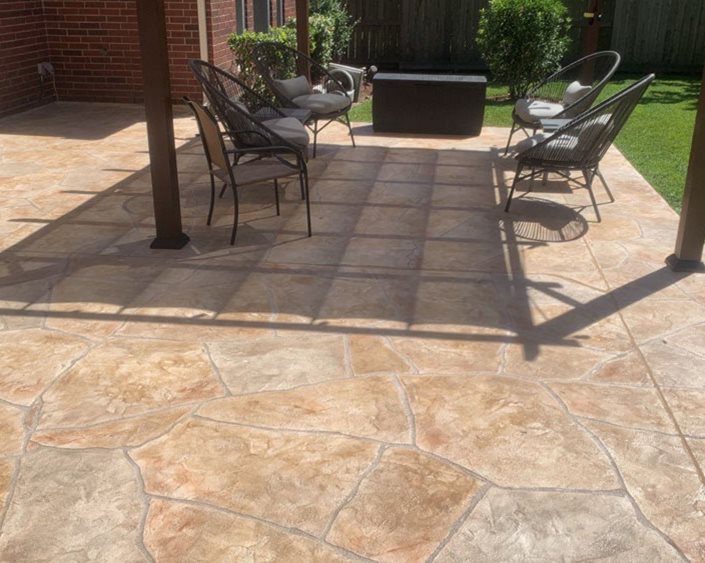
Patio Resurfacing: A Comprehensive Guide to Transforming Your Outdoor Space
Introduction
A well-maintained patio can be a focal point of your outdoor space, providing a comfortable and inviting area for relaxation, entertainment, and al fresco dining. However, over time, patios can become weathered, stained, or cracked, detracting from their aesthetic appeal and functionality. Patio resurfacing offers a cost-effective and durable solution to restore your patio to its former glory or enhance its appearance with a fresh new look.
Types of Patio Resurfacing Materials
The choice of resurfacing material depends on your desired aesthetic, budget, and lifestyle. Here are the most common options:
1. Concrete Overlay:
- Description: A thin layer of concrete applied over the existing patio surface, creating a smooth and durable finish.
- Pros: Affordable, customizable colors and textures, increased durability.
- Cons: May require additional reinforcement for heavily used patios.
2. Stamped Concrete:
- Description: Concrete overlay with decorative patterns and textures stamped into the surface.
- Pros: Wide range of design options, durable and weather-resistant.
- Cons: More expensive than plain concrete overlay, requires skilled installation.
3. Pavers:
- Description: Individual interlocking tiles made from concrete, stone, or brick.
- Pros: Versatility in design, easy to repair or replace individual pavers.
- Cons: Can be more expensive than other options, requires a stable base.
4. Tile:
- Description: Ceramic, porcelain, or natural stone tiles installed over a mortar or adhesive base.
- Pros: Durable, easy to clean, wide range of colors and patterns.
- Cons: Can be slippery when wet, requires professional installation.
5. Epoxy:
- Description: A resin-based coating applied over the existing patio surface.
- Pros: Seamless finish, highly resistant to wear and tear, easy to clean.
- Cons: Can be expensive, requires a clean and dry surface for installation.
Choosing the Right Resurfacing Material
Consider the following factors when selecting a resurfacing material:
1. Durability: The material should withstand heavy foot traffic, weather conditions, and potential stains.
2. Aesthetics: Choose a material that complements your home’s exterior and personal style.
3. Maintenance: Some materials require more frequent cleaning or sealing than others.
4. Budget: Resurfacing costs vary depending on the material and size of the patio.
Patio Resurfacing Process
1. Preparation:
- Remove all furniture and accessories from the patio.
- Clean the surface thoroughly with a pressure washer or cleaning solution.
- Repair any cracks or holes in the existing surface.
2. Installation:
- Concrete Overlay: Apply a primer to the surface and then pour the concrete overlay.
- Stamped Concrete: Stamp the desired patterns into the concrete overlay while it is still wet.
- Pavers: Install the pavers on a stable base, ensuring they are level and interlocking.
- Tile: Apply mortar or adhesive to the surface and install the tiles.
- Epoxy: Mix the epoxy and apply it to the surface using a roller or trowel.
3. Finishing:
- Concrete Overlay and Stamped Concrete: Seal the surface to protect it from moisture and stains.
- Pavers: Fill the joints between the pavers with sand or polymeric sand.
- Tile: Grout the joints between the tiles.
- Epoxy: Allow the epoxy to cure and then apply a clear topcoat for added protection.
Benefits of Patio Resurfacing
1. Enhanced Aesthetics: Resurfacing can transform the look of your patio, making it more visually appealing and inviting.
2. Increased Durability: New resurfacing materials are more durable than the original patio surface, protecting it from damage and wear.
3. Improved Functionality: Resurfacing can create a more level and slip-resistant surface, making it safer and more comfortable to use.
4. Reduced Maintenance: Some resurfacing materials require less maintenance than traditional patio surfaces, saving you time and effort.
5. Increased Property Value: A well-resurfaced patio can add value to your home by enhancing its curb appeal and outdoor living space.
DIY Patio Resurfacing vs. Professional Installation
1. DIY Patio Resurfacing:
- Pros: Less expensive, can be a rewarding project for experienced DIYers.
- Cons: Requires specialized tools and materials, may not achieve professional-quality results.
2. Professional Installation:
- Pros: Guaranteed quality, access to professional tools and techniques, peace of mind.
- Cons: More expensive than DIY, may require scheduling and availability.
Choosing a Patio Resurfacing Contractor
1. Get Recommendations: Ask friends, family, or neighbors for referrals.
2. Check Credentials: Verify the contractor’s license, insurance, and experience.
3. Get a Written Estimate: Obtain a detailed estimate that includes the cost of materials, labor, and any additional services.
4. Read Reviews: Check online reviews and testimonials to gauge the contractor’s reputation.
5. Communicate Clearly: Discuss your vision, budget, and timeline with the contractor to ensure a successful outcome.
Patio Resurfacing Maintenance
1. Regular Cleaning: Sweep or hose down the patio regularly to remove dirt and debris.
2. Stain Removal: Treat stains promptly using appropriate cleaning solutions.
3. Sealing: Seal the surface periodically to protect it from moisture and stains.
4. Joint Maintenance: For paver patios, inspect and fill joints with sand or polymeric sand as needed.
5. Winter Protection: Cover the patio with a tarp or snow cover during winter months to prevent damage from freezing and thawing.
Conclusion
Patio resurfacing is an effective way to revitalize your outdoor space and enhance its functionality and aesthetic appeal. By choosing the right material and following the proper installation and maintenance procedures, you can enjoy a beautiful and durable patio for years to come. Whether you opt for a DIY project or hire a professional contractor, patio resurfacing is a worthwhile investment that will transform your outdoor living experience.